一、环境要求
Hadoop+Hive+Spark+HBase 开发环境。
二、提交结果要求
1.必须提交源码或对应分析语句,如不提交则不得分。
2.带有分析结果的功能,请分析结果的截图与代码一同提交。
三、数据描述
UserBehavior 是阿里巴巴提供的一个淘宝用户行为数据集。本数据集包含了 2017-09-11
至 2017-12-03 之间有行为的约 5458 位随机用户的所有行为(行为包括点击、购买、加
购、喜欢)。数据集的每一行表示一条用户行为,由用户 ID、商品 ID、商品类目 ID、
行为类型和时间戳组成,并以逗号分隔。关于数据集中每一列的详细描述如下具体字段
说明如下:
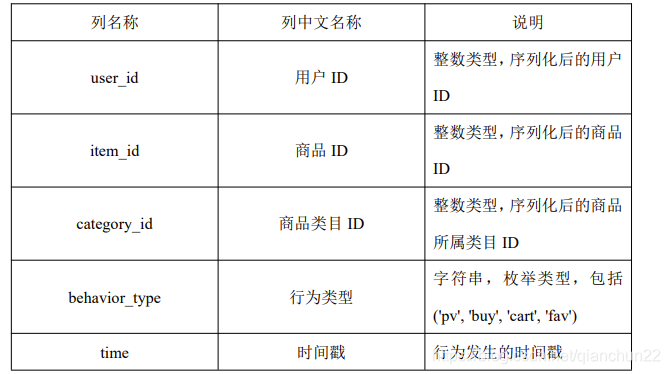
注意到,用户行为类型共有四种,它们分别是

四、功能要求
1.数据准备(10 分)
1 请在 HDFS 中创建目录/data/userbehavior,并将 UserBehavior.csv 文件传到该目录。(5 分)
[root@hadoop001 software]# hdfs dfs -mkdir -p /app/data/userbehavior
[root@hadoop001 software]# hdfs dfs -put UserBehavior.csv /app/data/userbehavior

2 通过 HDFS 命令查询出文档有多少行数据。(5 分)
[root@hadoop001 software]# hdfs dfs -cat /app/data/userbehavior/UserBehavior.csv | wc -l

2.数据清洗(40 分)
- 请在 Hive 中创建数据库 exam(5 分)
hive> create database exam202010;
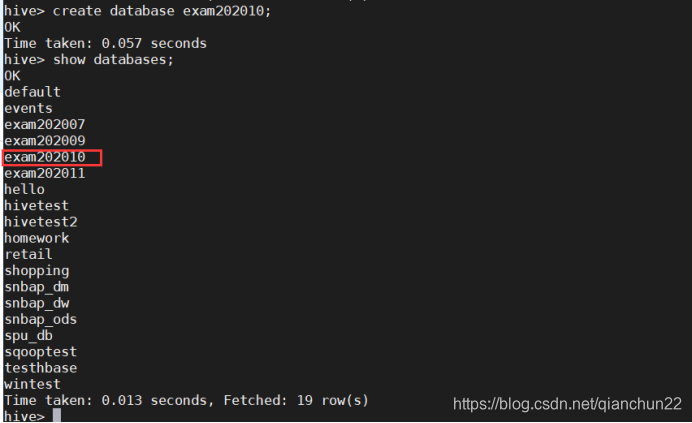
- 请在 exam 数据库中创建外部表 userbehavior,并将 HDFS 数据映射到表中(5 分)
hive> create external table userbehavior(
> user_id int,
> item_id int,
> category_id int,
> behavior_type string,
> time bigint
> )
> row format delimited
> fields terminated by ','
> stored as textfile
> location '/app/data/userbehavior';
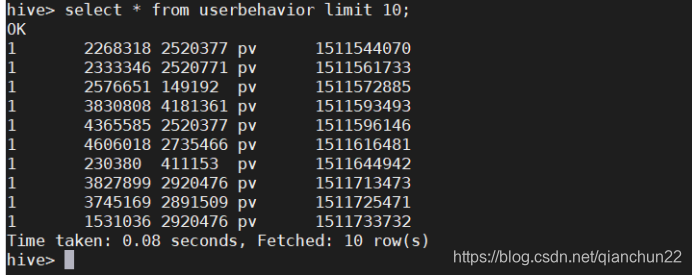
- 请在 HBase 中创建命名空间 exam,并在命名空间 exam 创建 userbehavior 表,包含一个列簇 info(5 分)
hbase(main):047:0> create_namespace 'exam202010'
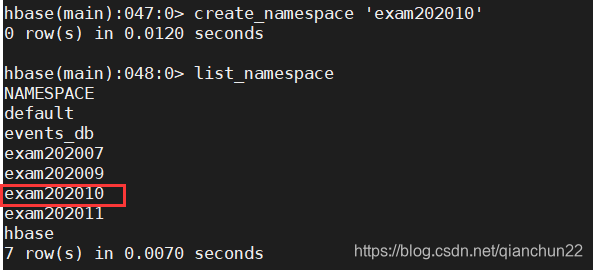
hbase(main):049:0> create 'exam202010:userbehavior','info'

- 请在 Hive 中创建外部表 userbehavior_hbase,并映射到 HBase 中(5 分),并将数据加载到 HBase 中(5 分)
hive> create external table userbehavior_hbase(
> user_id int,
> item_id int,
> category_id int,
> behavior_type string,
> time bigint
> )
> stored by 'org.apache.hadoop.hive.hbase.HBaseStorageHandler'
> with serdeproperties('hbase.columns.mapping'=':key,
> info:item_id,
> info:category_id,
> info:behavior_type,
> info:time')
> tblproperties('hbase.table.name'='exam202010:userbehavior');

hive> insert into userbehavior_hbase select * from userbehavior;

- 请在 exam 数据库中创建内部分区表 userbehavior_partitioned(按照日期进行分区),并通过查询 userbehavior 表将时间戳格式化为”年-月-日 时:分:秒”格式,将数据插入至 userbehavior_partitioned 表中,例如下图:(15 分)
hive> set hive.exec.dynamic.partition=true;
hive> set hive.exec.dynamic.partition.mode=nonstrict;
hive> create table userbehavior_partitioned(
> user_id int,
> item_id int,
> category_id int,
> behavior_type string,
> time string
> )
> partitioned by (dt string)
> stored as orc;
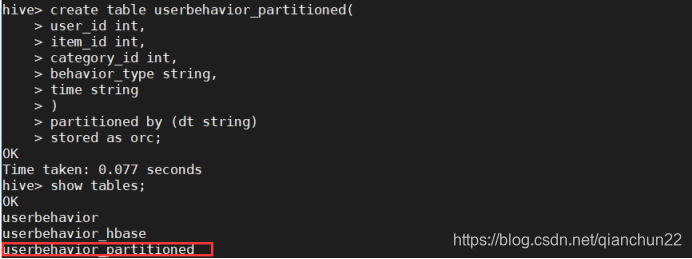
hive> insert into userbehavior_partitioned partition(dt)
> select user_id,item_id,category_id,behavior_type,from_unixtime(time,"yyyy-MM-dd HH:mm:ss") as time,from_unixtime(time,"yyyy-MM-dd") as dt
> from userbehavior;

3.用户行为分析(20 分)
请使用 Spark,加载 HDFS 文件系统 UserBehavior.csv 文件,并分别使用 RDD 完成以下 分析。
scala> val lines = sc.textFile("hdfs://hadoop001:9000/app/data/userbehavior/UserBehavior.csv")
1) 统计 uv 值(一共有多少用户访问淘宝)(10 分)
scala> lines.map(_.split(",")).map(x => (x(0),1)).groupBy(_._1).count

2)分别统计浏览行为为点击,收藏,加入购物车,购买的总数量(10 分)
scala> lines.map(_.split(",")).map(x => (x(3),1)).reduceByKey(_+_).collect.foreach(println)

4.找出有价值的用户(30 分)
1)使用 SparkSQL 统计用户最近购买时间。以 2017-12-03 为当前日期,计算时间范围 为一个月,计算用户最近购买时间,时间的区间为 0-30 天,将其分为 5 档,0-6 天,7-12 4 天,13-18 天,19-24 天,25-30 天分别对应评分 4 到 0(15 分)
scala> val sqlString="""
| with temptb as (select user_id,DATEDIFF('2017-12-03',MAX(time)) as ltime from exam202010.userbehavior_partitioned where dt between '2017-11-03' and '2017-12-03' and behavior_type='buy' group by user_id)
| select user_id,
| (case when ltime between 0 and 6 then 4
| when ltime between 7 and 12 then 3
| when ltime between 13 and 18 then 2
| when ltime between 19 and 24 then 1
| when ltime between 25 and 30 then 0
| else null end) level
| from temptb
| """
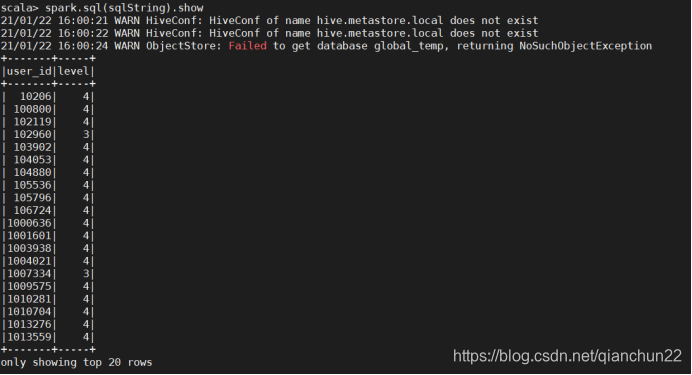
2)使用 SparkSQL 统计用户的消费频率。以 2017-12-03 为当前日期,计算时间范围为 一个月,计算用户的消费次数,用户中消费次数从低到高为 1-161 次,将其分为 5 档,1-32,33-64,65-96,97-128,129-161 分别对应评分 0 到 4(15 分)
scala> val sqlString="""
| with temptb as (select user_id,count(item_id) as buycount from exam202010.userbehavior_partitioned where dt between '2017-11-03' and '2017-12-03' group by user_id)
| select user_id,
| (case when buycount between 1 and 32 then 0
| when buycount between 33 and 64 then 1
| when buycount between 65 and 96 then 2
| when buycount between 97 and 128 then 3
| when buycount between 129 and 161 then 4
| else null end) level
| from temptb
| """
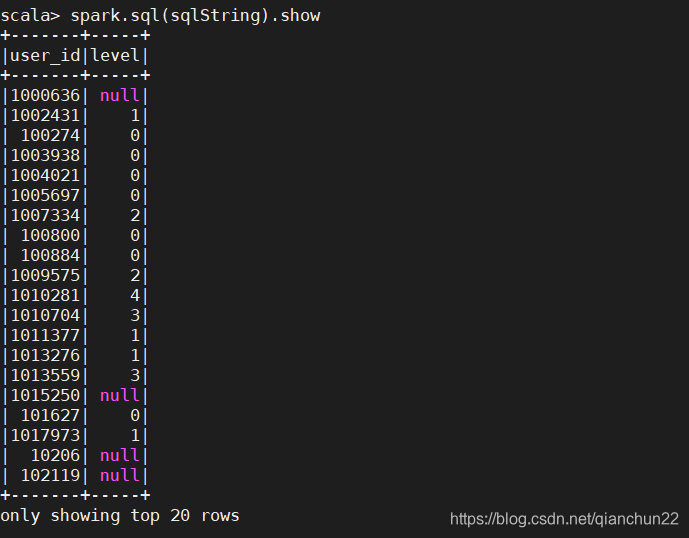
























 608
608

 被折叠的 条评论
为什么被折叠?
被折叠的 条评论
为什么被折叠?








